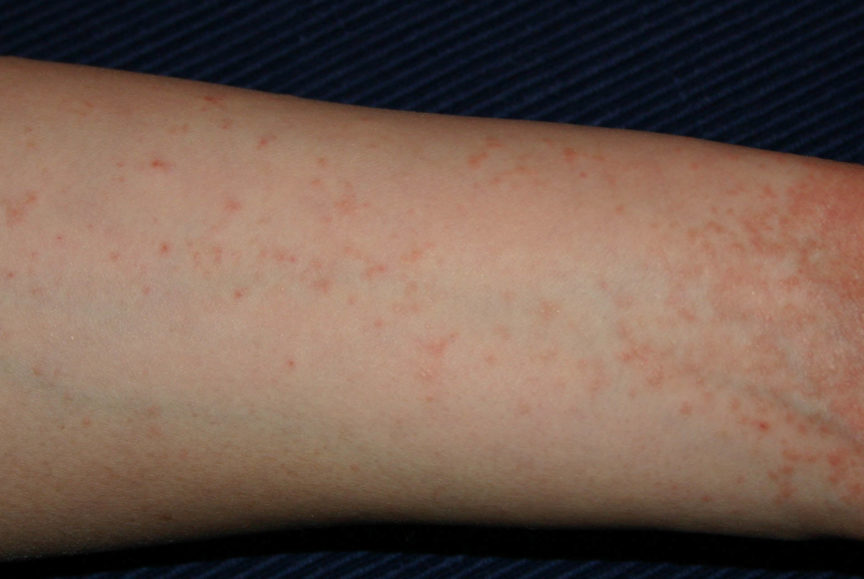What is Scabies in Children
The scabies rash, caused by microscopic mites that burrow into the skin’s upper layers, is an extremely itchy and contagious skin infection. Scabies is an infection that can be passed not only in children, but people of all ages.
What are the Symptoms of Scabies
There are many different skin rashes caused by thousands of culprits, from allergies to infections, there are signs that help to differentiate scabies from of rashes.
After the mites responsible for scabies have entered the skin it usually takes about 2 to 4 weeks for the rash to appear. The rash itself is the body’s reaction to the proteins, eggs and other excretions from the mites in the skin. The rash can be extremely itchy with the irritation increasing at night. Another sign that the rash is from a scabies infection can be the presence of thin, threadlike gray or white lines on the skin from the burrowing mites. These lines resemble irregular pencil marks.
Scabies in children younger than 2 years old the rash is most commonly found on the palms, soles of the feet, head and neck. Older children usually develop the rash in between the fingers or in the folds and creases at the wrists, elbows, waistline, thighs, buttocks and genitals.
Scabies has an incubation period of usually 4 to 6 weeks, however, if scabies has previously infected your child, symptoms can occur much quicker. Symptoms can occurs as quickly as 1 to 4 days after being exposed to the mites again.
What Caregivers Can Do for Scabies in Children
Scabies is extremely itchy and irritating, however scratching will only increase the chances of the skin developing a secondary bacterial infection. You can help your child by helping them not to scratch and keeping their fingernails trimmed during a scabies infection.
When to Call Your Child’s Doctor
If you notice or your child complains of an itch rash, contact your child’s doctor. The doctor will need to examine the rash to make a diagnoses and recommend treatment for the scabies infection.
Diagnosing Scabies
Your child’s pediatrician can often diagnose a scabies infection by examining the rash and asking about the intensity of the rash’s itchiness. Scabies can be difficult to identify due to the fact that children are usually unable to resist scratching this highly irritating rash, cause scratch marks and crusting.
If your pediatrician decides they need to confirm the diagnoses they may take a gentle scraping from the rash or a burrow. The sample will be examined under a microscope to identify the scabies mites or its eggs.
Treatment for Scabies in Children
Children with a scabies rash will need to be cared for with one of several lotion or cream options. These lotions and creams include:
- Permethrin 5% cream
- Crotamiton 10% lotion or cream
- Lindane lotion (safe only for children over 2 years of age)
For most cases, pediatricians choose a permethrin 5% cream. The cream needs to be applied over the entire body from the neck all the way down to the toes. For infants and young children it will also need to be applied to the head and scalp as the mites can infect these parts of the body in small children.
Although other creams and lotions can be used, such as crotamiton 10%, permethrin is most commonly used for treating scabies in children. Talk to your pediatrician about how often the cream or lotion should be reapplied. Often treatment should be reapplied about a week after the initial treatment.
Scabies is a very persistent rash. Even after being effectively treated, the itching associated with scabies can last for several weeks and even months. Although this continued irritation is frustrating for both parents and children, it does not mean that your child still has the scabies infection. To help relieve the itching, talk to your child’s doctor about an oral antihistamine or a topical corticosteroid. Keep your child’s fingernail trimmed and encourage them not to itch to avoid further infection.
Prognosis
Although scabies is very contagious, produces extreme itchiness and discomfort, the condition is mild and highly treatable. Once your child has completed their treatment for scabies they can return to school or childcare.
What Parents Can Do to Help Prevent Scabies
The mites that cause a scabies infestation are easily spread from person to person through close contact, especially skin to skin. If a family member has scabies, talk to your healthcare provider about whether other family members should be tested or treated for scabies.
To help prevent a second infestation clean all clothes and linens using hot, soapy water and dry with high heat. For items that your child has come into contact with that cannot be washed, try to “starve the mites” by sealing objects in a plastic bag out of the way for a couple weeks. The mites will die after a few days without food.
The Pediatric Center is Here For You
If you think your child may have scabies do not hesitate to call your child’s pediatrician to have your child check out. Remember these key points about identifying scabies:
- Location of rash
- Increased itch at night
- Threadlike gray or white lines
Keep in mind that scabies, although irritating and very itchy and uncomfortable, it is highly treatable. If you want to learn more or have further concerns about scabies in children or treatment options for you child, give us a call at The Pediatric Center. We are here to help you best help your child.
Featured image: By Steschke – Own work, https://commons.wikimedia.org/w/index.php?curid=37900


